Abstract
Restriction fragment length polymorphism of ribosomal DNA regions (ribotyping) of Pseudomonas aeruginosa was evaluated as a tool for epidemiological purposes. Fifty-five epidemiologically unrelated isolates from three geographic areas of Switzerland and 11 isolates obtained during an outbreak of P. aeruginosa infections in a burn unit were typed by this method. Typeability and reproducibility of the method reached 100%. With four selected restriction enzymes (BamHI, ClaI, EcoRI, and PstI), the 55 unrelated isolates could be classified into 33 ribotypes. To assess the value of this method for the interpretation of epidemiological data, we calculated an index of discrimination (ID) which takes into consideration both the number of types defined by the typing method and their relative frequencies. Our ribotyping system obtained a high ID of 0.958 with only four restriction enzymes, comparing well with other different typing schemes for which ID values could be calculated from published data. All clinical isolates of the outbreak belonged to the same ribotype, whereas environmental isolates, initially thought to be the source of the epidemic, belonged to a different ribotype. Thus, the typeability, reproducibility, and discriminatory power of our method as well as its value established in an epidemiological investigation were found to be appropriate for further epidemiological studies of P. aeruginosa.
Full text
PDF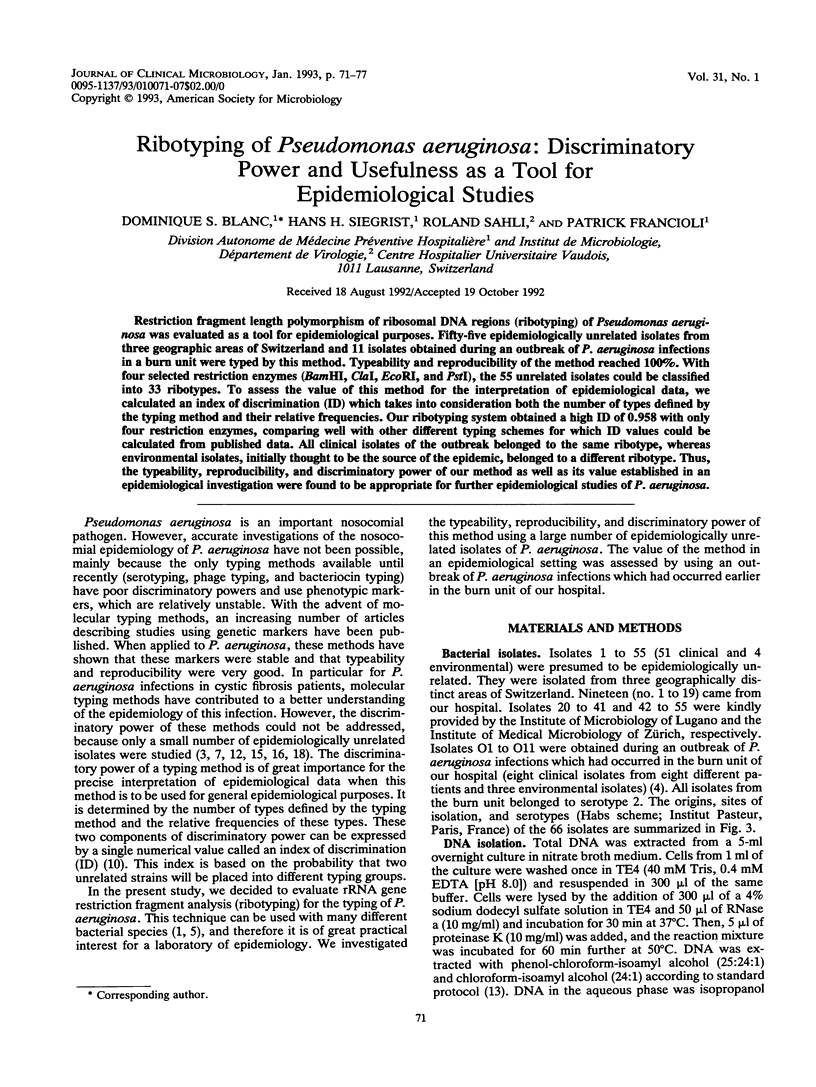
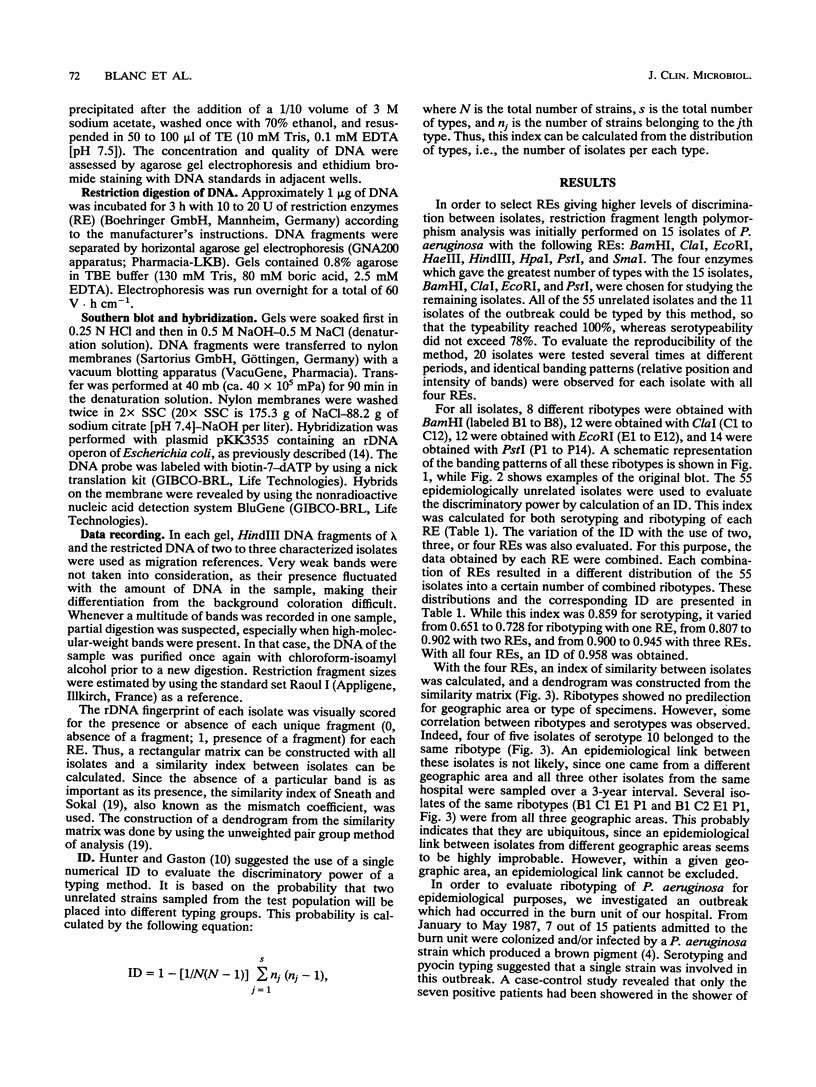
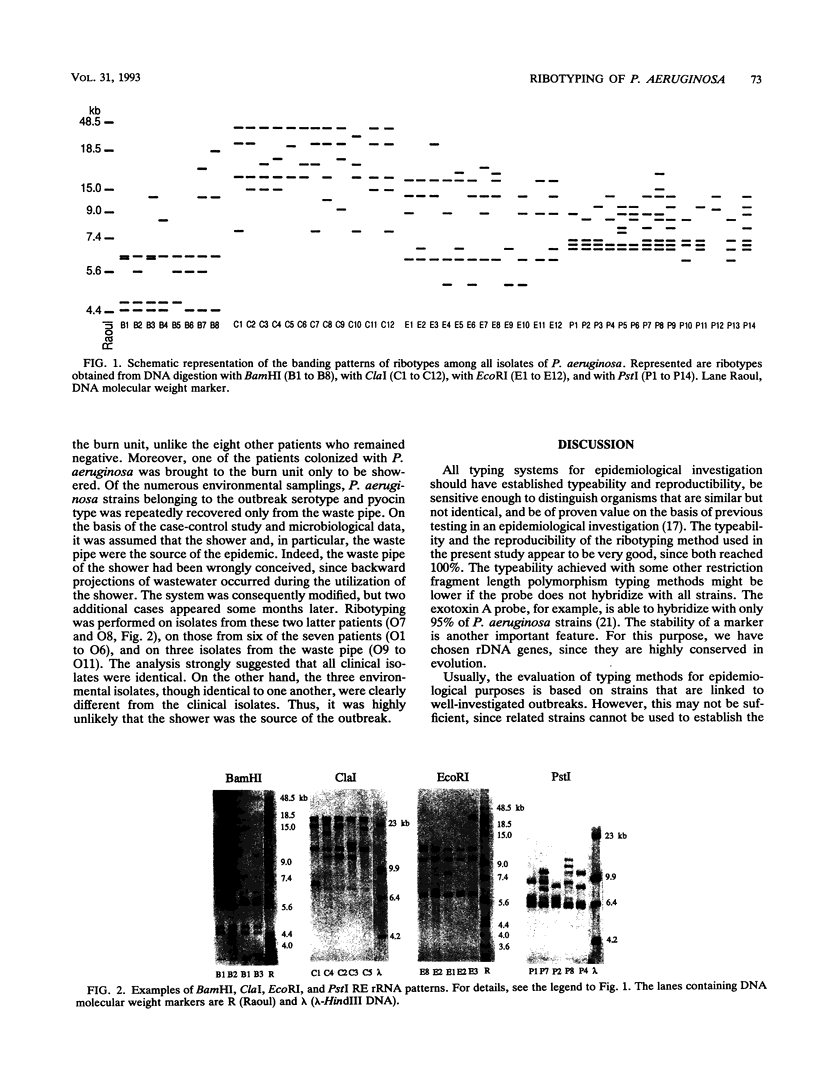
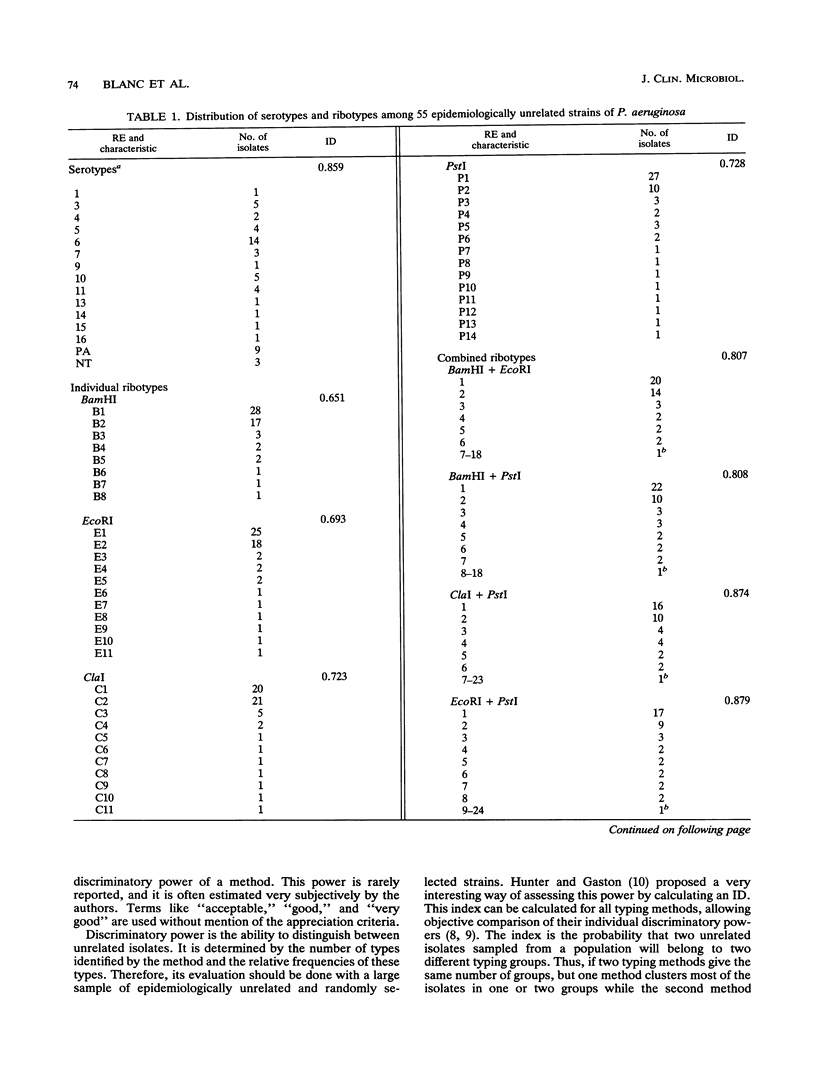
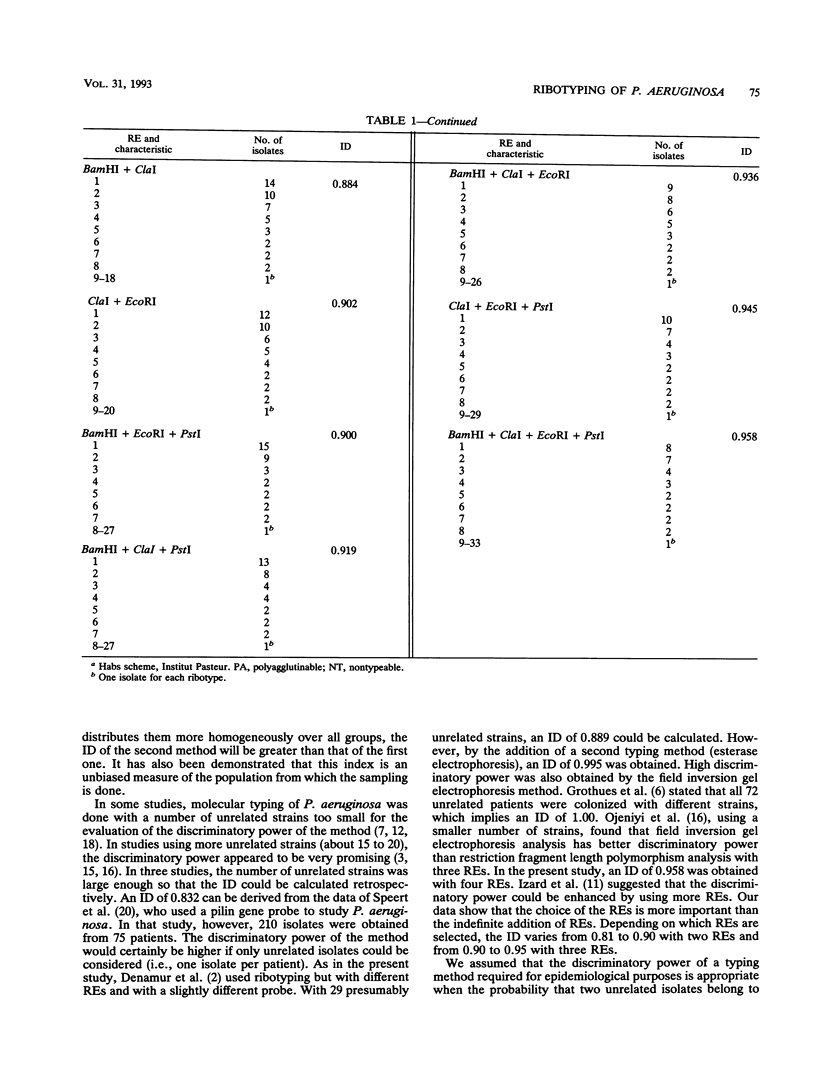
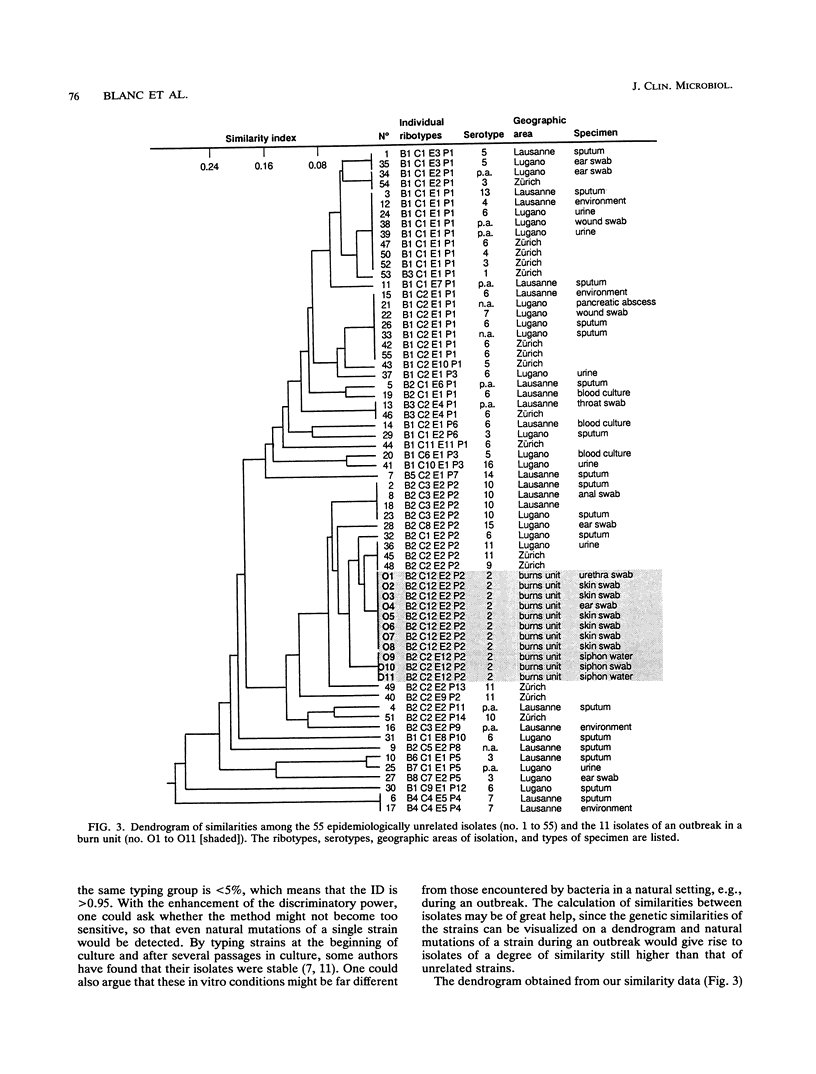
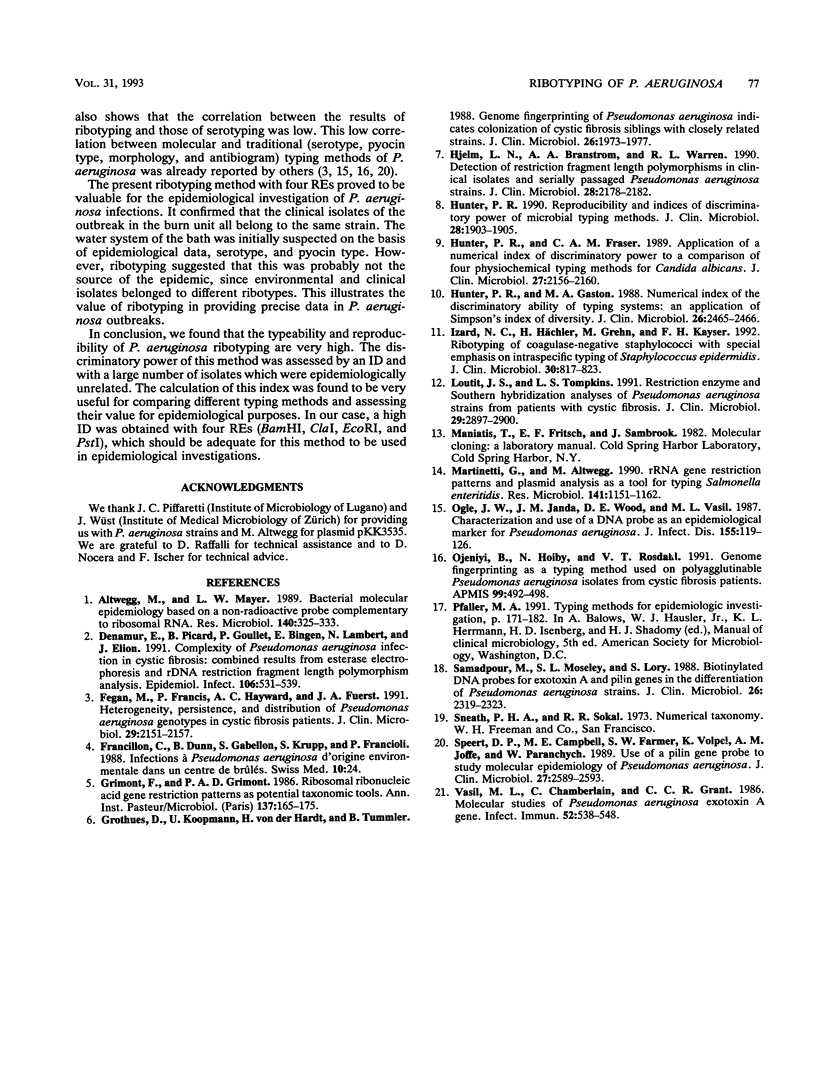
Images in this article
Selected References
These references are in PubMed. This may not be the complete list of references from this article.
- Altwegg M., Mayer L. W. Bacterial molecular epidemiology based on a nonradioactive probe complementary to ribosomal RNA. Res Microbiol. 1989 May-Jun;140(4-5):325–333. doi: 10.1016/0923-2508(89)90024-7. [DOI] [PubMed] [Google Scholar]
- Denamur E., Picard B., Goullet P., Bingen E., Lambert N., Elion J. Complexity of Pseudomonas aeruginosa infection in cystic fibrosis: combined results from esterase electrophoresis and rDNA restriction fragment length polymorphism analysis. Epidemiol Infect. 1991 Jun;106(3):531–539. doi: 10.1017/s0950268800067595. [DOI] [PMC free article] [PubMed] [Google Scholar]
- Fegan M., Francis P., Hayward A. C., Fuerst J. A. Heterogeneity, persistence, and distribution of Pseudomonas aeruginosa genotypes in cystic fibrosis patients. J Clin Microbiol. 1991 Oct;29(10):2151–2157. doi: 10.1128/jcm.29.10.2151-2157.1991. [DOI] [PMC free article] [PubMed] [Google Scholar]
- Grimont F., Grimont P. A. Ribosomal ribonucleic acid gene restriction patterns as potential taxonomic tools. Ann Inst Pasteur Microbiol. 1986 Sep-Oct;137B(2):165–175. doi: 10.1016/s0769-2609(86)80105-3. [DOI] [PubMed] [Google Scholar]
- Grothues D., Koopmann U., von der Hardt H., Tümmler B. Genome fingerprinting of Pseudomonas aeruginosa indicates colonization of cystic fibrosis siblings with closely related strains. J Clin Microbiol. 1988 Oct;26(10):1973–1977. doi: 10.1128/jcm.26.10.1973-1977.1988. [DOI] [PMC free article] [PubMed] [Google Scholar]
- Hjelm L. N., Branstrom A. A., Warren R. L. Detection of restriction fragment length polymorphisms in clinical isolates and serially passaged Pseudomonas aeruginosa strains. J Clin Microbiol. 1990 Oct;28(10):2178–2182. doi: 10.1128/jcm.28.10.2178-2182.1990. [DOI] [PMC free article] [PubMed] [Google Scholar]
- Hunter P. R., Fraser C. A. Application of a numerical index of discriminatory power to a comparison of four physiochemical typing methods for Candida albicans. J Clin Microbiol. 1989 Oct;27(10):2156–2160. doi: 10.1128/jcm.27.10.2156-2160.1989. [DOI] [PMC free article] [PubMed] [Google Scholar]
- Hunter P. R., Gaston M. A. Numerical index of the discriminatory ability of typing systems: an application of Simpson's index of diversity. J Clin Microbiol. 1988 Nov;26(11):2465–2466. doi: 10.1128/jcm.26.11.2465-2466.1988. [DOI] [PMC free article] [PubMed] [Google Scholar]
- Hunter P. R. Reproducibility and indices of discriminatory power of microbial typing methods. J Clin Microbiol. 1990 Sep;28(9):1903–1905. doi: 10.1128/jcm.28.9.1903-1905.1990. [DOI] [PMC free article] [PubMed] [Google Scholar]
- Izard N. C., Hächler H., Grehn M., Kayser F. H. Ribotyping of coagulase-negative staphylococci with special emphasis on intraspecific typing of Staphylococcus epidermidis. J Clin Microbiol. 1992 Apr;30(4):817–823. doi: 10.1128/jcm.30.4.817-823.1992. [DOI] [PMC free article] [PubMed] [Google Scholar]
- Loutit J. S., Tompkins L. S. Restriction enzyme and Southern hybridization analyses of Pseudomonas aeruginosa strains from patients with cystic fibrosis. J Clin Microbiol. 1991 Dec;29(12):2897–2900. doi: 10.1128/jcm.29.12.2897-2900.1991. [DOI] [PMC free article] [PubMed] [Google Scholar]
- Martinetti G., Altwegg M. rRNA gene restriction patterns and plasmid analysis as a tool for typing Salmonella enteritidis. Res Microbiol. 1990 Nov-Dec;141(9):1151–1162. doi: 10.1016/0923-2508(90)90088-8. [DOI] [PubMed] [Google Scholar]
- Ogle J. W., Janda J. M., Woods D. E., Vasil M. L. Characterization and use of a DNA probe as an epidemiological marker for Pseudomonas aeruginosa. J Infect Dis. 1987 Jan;155(1):119–126. doi: 10.1093/infdis/155.1.119. [DOI] [PubMed] [Google Scholar]
- Ojeniyi B., Høiby N., Rosdahl V. T. Genome fingerprinting as a typing method used on polyagglutinable Pseudomonas aeruginosa isolates from cystic fibrosis patients. APMIS. 1991 Jun;99(6):492–498. [PubMed] [Google Scholar]
- Samadpour M., Moseley S. L., Lory S. Biotinylated DNA probes for exotoxin A and pilin genes in the differentiation of Pseudomonas aeruginosa strains. J Clin Microbiol. 1988 Nov;26(11):2319–2323. doi: 10.1128/jcm.26.11.2319-2323.1988. [DOI] [PMC free article] [PubMed] [Google Scholar]
- Speert D. P., Campbell M. E., Farmer S. W., Volpel K., Joffe A. M., Paranchych W. Use of a pilin gene probe to study molecular epidemiology of Pseudomonas aeruginosa. J Clin Microbiol. 1989 Nov;27(11):2589–2593. doi: 10.1128/jcm.27.11.2589-2593.1989. [DOI] [PMC free article] [PubMed] [Google Scholar]
- Vasil M. L., Chamberlain C., Grant C. C. Molecular studies of Pseudomonas exotoxin A gene. Infect Immun. 1986 May;52(2):538–548. doi: 10.1128/iai.52.2.538-548.1986. [DOI] [PMC free article] [PubMed] [Google Scholar]



